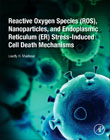
Reactive Oxygen Species (ROS), Nanoparticles, and Endoplasmic Reticulum (ER) Stress-Induced Cell Death Mechanisms: Antioxidant Therapeutic Defenses
Madkour, Loutfy H.
Reactive Oxygen Species (ROS), Nanoparticles, and Endoplasmic Reticulum (ER) Stress-Induced Cell Death Mechanisms presents the understanding about the roles of ROS?mediated pathways cellular signaling stress, endoplasmic reticulum (ER) stress, oxidative stress, oxidative damage, nanomaterials, and the mechanisms by which metalloids and nanoparticles induce their toxic effects. Over seven chapters, the book covers the ecotoxicology of environmental heavy metal ions and free radicals on macromolecules cells organisms as well as heavy metals?induced cell responses and oxidative stress. It discusses the source of oxidants and the roles of ROS, oxidative stress and oxidative damage mechanisms. The book also examines the nanotoxicity, cytotoxicity and genotoxicity mechanisms of nanomaterials and the effects of nanoparticles interactions on the activities of oxidative stress. Lastly, antioxidant defense therapy and strategies for treatment round out the book making Reactive Oxygen Species (ROS), Nanoparticles, and Endoplasmic Reticulum (ER) Stress-Induced Cell Death Mechanisms a resource to researchers and professional scientists in toxicology, environmental chemistry, environmental science, nanomaterials, and pharmaceutical sciences. Covers the ecotoxicology of environmental heavy metal ions and the interactions between specific heavy metals?induced cell responses and oxidative stressProvide better understanding of the mechanism of nanomaterial-induced toxicity as a first defense for hazard prevention and covers recent advances in new nanomedication technologies for the effects of NPs on oxidative stress, ROS and ER stressDiscusses the effects of interactions between antioxidant defense therapy and ROS and strategies for treatment which includes possible benefits of antioxidants supplementation to achieve the optimum effects INDICE: 1. Ecotoxicology of Environmental Heavy Metal Ions and Free Radicals on Macromolecules Cells Organisms 2. Nanotoxicity, Cytotoxicity and Genotoxicity Mechanisms of Nanomaterials 3. Sources of Oxidants and Function of (ROS) inside the Macromolecules Cells 4. The Roles and Mechanisms of ROS, Oxidative Stress and Oxidative Damage 5.Consequences of Oxidative Stress and ROS?Mediated Pathways Cellular Signaling Stress Response 6. Interactions between Heavy Metals?Induced Cell Responses and Oxidative Stress 7. Pathways for Nanoparticles NPs- Induced Oxidative Stress 8. Role of Endoplasmic Reticulum ER Stress?Induced Cell Death Mechanisms 9. Endoplasmic Reticulum (ER) Stress as a Mechanism for NP Induced Toxicity 10. Advances Nanotechnology and Effects of Nanoparticles on Oxidative Stress Parameters 11. Improvement Testing Strategy for Aligning Nanomaterial Safety Assessments and Oxidative Stress Responses 12. Effects of Interactions between Antioxidant Defences Therapy and ROS
- ISBN: 978-0-12-822481-6
- Editorial: Academic Press
- Encuadernacion: Rústica
- Páginas: 250
- Fecha Publicación: 01/08/2020
- Nº Volúmenes: 1
- Idioma: Inglés
